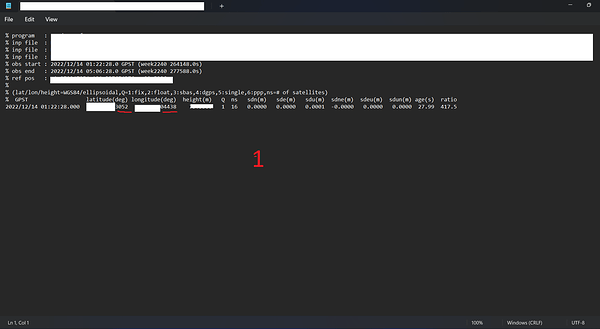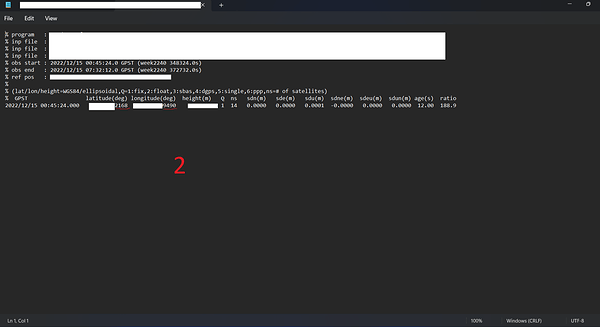Hi, I want to ask a question. Can someone tell me about .POS FILE? I mean, what the meaning of ratio, sdne, and many more. Because when I do a Static Pos Processing (in same point but different day and time of measurement), I always got different sdne, ratio and many more. Can someone explain about .POS FILE? I only know Q is a quality of data, if Q = 1 is the meaning of FIXED data. I have 2 units EMLID RS2 and I always do a measurement with 2 units GPS as a Base and a receiver.
I measured at this point for 8 hours.
Sure…
NS = number of satellites
SDN, SDE, & SDU = The standard deviation in the north, east, and up directions.
SDNE, SDEU, & SDUN = represent the cross-correlation errors between the East, North, and Up directions, respectively. SDNE represents the error between the East and North directions, SDEU represents the error between the East and Up directions, and SDUN represents the error between the North and Up directions.
AGE = represents the time difference between the position measurement and the most recent correction or reference data used in the processing. A lower value in this column indicates a more recent correction or reference data was used, which generally indicates a more accurate position measurement.
RATIO = represents the ratio of the residual to the expected error for the position measurement. A lower value in this column indicates that the position measurement is more reliable and has a higher confidence level.
so, if I measure 2 Benchmarks with the same point on different days and with different measurement time, the smaller ratio results have better data accuracy? I think a bigger ratio means better data.
let me include the results of my measurements.
-picture 1 shows a larger ratio and I took about 4 hours of measurement. I took measurements on December 14, 2022.
-picture 2 shows a smaller ratio and I took about 6 hours of measurement. I took measurements on December 15, 2022.
*the red lines are 4 different numbers and affect the results of the coordinates.
I may have been incorrect on the ratio, as it may not have been what I thought it was. I found some other articles…
The first link states, "
The AR ratio factor is the residuals ratio between the best solution and the second best solution while attempting to resolve the integer cycle ambiguities in the carrier-phase data. In general, the larger this number, the higher confidence we have in the fixed solution. If the AR ratio exceeds a set threshold, then the fixed solution is used, otherwise the float solution is used. I have left this threshold at its default value of 3.0"
Right now I am not sure what the ratio means in the POS file. If it’s the AR ratio, then it sounds like a higher number is better.
Maybe someone with some better understanding could chime in.
okay thank u for sharing me.
Hi @arsifalf,
@snillor999 has already explained it, so I just wanted to add a couple of words about the AR ratio. In simple words, it shows how many times the best solution is better than the next one. The AR ratio higher than 3 corresponds to a Fix solution. So, in your case, both positions are accurate.






